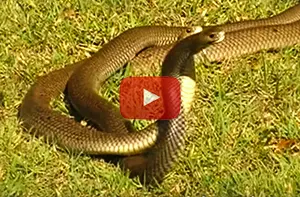Eastern Brown Snake Common Brown Snake

Contents
Eastern Brown Snake Description
The Eastern Brown Snake, also known as the Common Brown Snake, is a highly venomous, fast-moving Australian snake. It is the second most venomous snake in the world and is responsible for the most snake-bite deaths in Australia.
The eastern brown snake has a long slender reptile reaching 1.5 to 2.0 meters in length and has a small head that blends into its body without any noticeable indentation. They range in colour from dark brown to light tan or burnt orange, with lighter-coloured snakes having a uniform colour and darker ones having a paler head colour. The snake's belly is usually cream, yellow, or pale orange with darker pink or orange blotches. Its body scales are smooth and slightly glossy, The snake's medium-sized orange eyes have round black pupils below a prominent brow ridge. Like most snakes, it is deaf, has a forked tongue, and no eyelids. Males are typically larger than females.
Despite it deadliness, the Eastern Brown Snake , it is not naturally aggressive towards humans. Most bites occur when humans attempt to handle or kill the snake. The eastern Brown Snake's scientific name is Pseudonaja textilis.
Eastern Brown Snake Bite
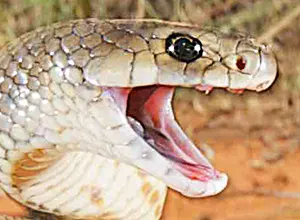
Photo: Eastern Brown Snake read to strike
An eastern brown snake's bite can kill a human in with 4 hours, as its venom is extremely toxic. If approached, the snake will try to avoid detection or flee. However, if the snake feels threatened or is startled, it may react defensively and strike at any perceived threat, including humans. During a low-level attack, the snake will flatten its neck and strike at the victim, usually around the feet, ankles, and calves. These bites are less likely to deliver a venom-rich bite due to the angle of attack. In a high-level attack, the snake will lift most of its body off the ground, coil its neck into an "S" shape, and strike with great speed and accuracy, injecting venom into its victim. These attacks usually result in bites to the thigh in humans.
The eastern brown snake belongs to the elapid family of snakes, meaning it has hollow syringe-like venom-injecting fangs in the front of its mouth. It has relatively tiny fangs (approximately 3mm) but makes up for this with the extremely high toxicity of its venom.
Dying from a Snake Bite
You are 50 times more likely to die from falling off your bed than from a snake bite.
Eastern Brown Snake Venom What Happens Once Bitten
Eastern brown snake venom is the second most potent snake venom in the world. Venom from an Eastern Brown snake bite can kill a human within 4 hours. Drop for drop, it is 12 times more deadly than an equivalent amount of Indian cobra venom. Eastern brown snake venom contains fast-acting pre-synaptic neurotoxins, procoagulants, cardiotoxins and nephrotoxins that cause progressive paralysis, uncontrollable bleeding, respiratory failure and death. Because of its small fangs (about 3mm), the initial bite is painless and often difficult to detect. It can kill a human within 4 hours. Once symptoms appear, however, progression is very rapid, and death can be sudden and unexpected. Therefore, prompt administration of antivenom is required to prevent death.
Eastern Brown Snake Habitat
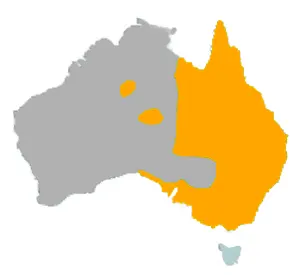
Photo: Eastern Brown Snake Habitat Map
The eastern brown snake lives in a variety of habitats throughout eastern Australia, including open grasslands, pastures, woodlands, and even on the outskirts of urban areas. They are particularly common in farmland and areas close to water courses in arid regions. The snake's diet of rodents may explain its affinity for areas close to human habitation. The eastern brown snake's distribution ranges from northern Queensland to South Australia, with isolated populations in the Barkly Tableland and the MacDonnell Ranges in the Northern Territory. They are absent from rainforests, alpine regions, and the island of Tasmania. When inactive, they seek shelter beneath fallen logs, rocks, fissures in the earth, animal burrows, and even human structures and rubbish.
Eastern Brown Snake Diet
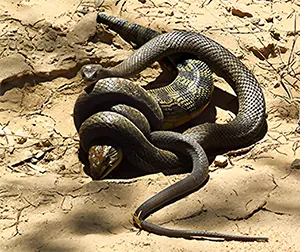
Photo: Eastern Brown Snake killing a skink
The eastern brown snake is a carnivorous reptile that primarily feeds on vertebrates, including frogs, lizards, birds, mammals, and eggs. However, since European settlement who introduced rabbits, rats and mice, these introduced animals have become a favourite delicacy for the snake. Larger snakes mostly eat warm-blooded animals, while the smaller ones prefer exothermic prey such as lizards. The eastern brown snake rarely eats during winter. And females may not eat at all while carrying eggs.
The eastern brown snake hunts during the cooler daylight hours, relying primarily on sight to locate its prey. Once spotted, the snake chases its victim at high speeds. Then, it kills its victim by injecting venom and, for larger prey, constricting and suffocating it. The eastern brown snake can dislocate its jaw and stretch its skin to swallow large prey. While most animals succumb to its venom, the breaded dragon lizard fights back and often escapes. Also, the eastern brown snake has learned to avoid cane toad, whose poisons are highly toxic.
Eastern Brown Snake Reproduction & Life Cycle
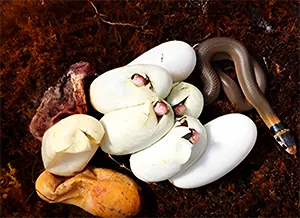
Photo: Eastern Brown Snake hatchlings
Eastern brown snakes mate in mid to late spring. Males engage in ritual combat where they intertwine their bodies and wrestle with one another in an attempt to overpower the other. The stronger usually wins and gains access to the receptive female. Copulation can last up to two hours, and the female may store sperm for several weeks after mating. The female lays a clutch of about 15 eggs and abandons the eggs. Depending on the incubation temperature in the nest, eggs will hatch about 36 to 95 days after being laid.
The size of hatchlings varies greatly, from 189-275mm and 4-10gm. All hatchlings have a common head banding but differ greatly in the patterns and bandings on their bodies. These markings fade as they mature. Hatchlings are independent from birth and acquire the distinctive threat display characteristic of their species within 15 minutes of hatching. Eastern brown snake juveniles reach sexual maturity at about 31 months of age.
An eastern brown snake has a lifespan of 7-10 years.
Eastern Brown Snake Predators & Threats
Animals that prey on the eastern brown snakes include birds of prey and feral cats. Large numbers of these snakes are also killed by humans. Road kills too, claim a large number of these snakes.
Is the Eastern Brown Snake Endangered?
Given the eastern brown snake's ability to easily adapt to human environmental activities such as farming and urbanisation, they are not considered endangered.
Helpful Hint to Prevent Being Bitten by a Eastern Brown Snake
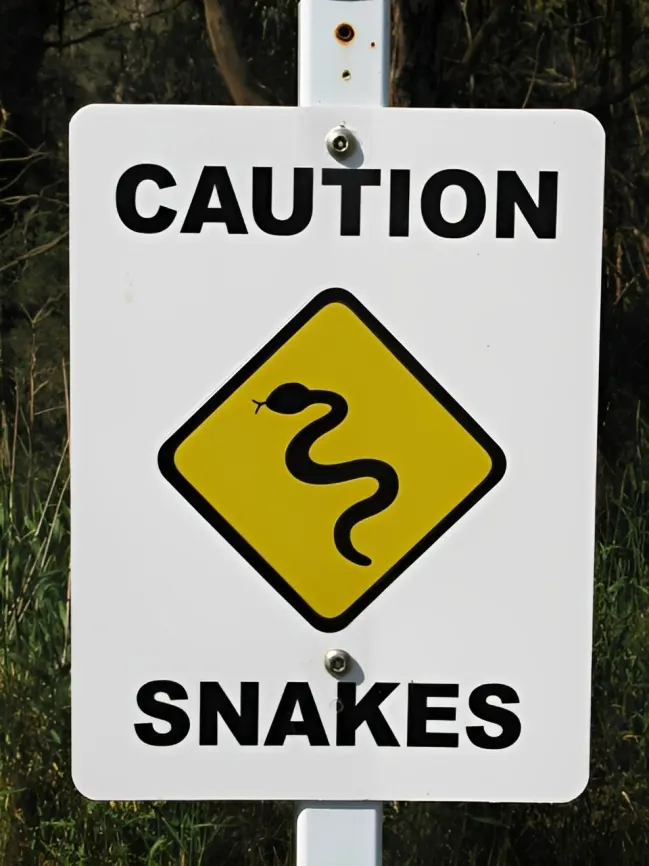
Photo: Snake Warning Sign
Most snake bites occur as a direct result of people trying to kill snakes. The simplest safety precaution is the leave the snake alone. Move away slowly and calmly and let it slither away on its own accord. Call a snake-catcher if necessary to remove it. Do not attempt to handle a snake even if it appears dead as it can reflex bite up to several hours after death.
When travelling through areas the snake is likely to inhabit, avoid going off the beaten track and into dense undergrowth. Wearing long pants, thick socks and solid footwear will greatly reduce the chances of suffering from a snake bite.
25 Eastern Brown Snake Facts
- The eastern brown snake is a large, fast-moving venomous Australian snake.
- It has a slender brown body and can grow to 2m in length.
- The eastern brown snake has a small head that blends into its body without any noticeable indentation.
- The eastern brown snake can move as fast as a human can run.
- The eastern brown snake is the second most venomous snake in the world.
- It is responsible for about 60% of snakebite deaths in Australia.
- Even a newly born hatchling has enough venom to kill a human.
- This snake has relatively small fangs, but its venom is highly toxic.
- The initial bite is generally painless and often difficult to detect.
- This snake prefers avoiding humans.
- You are 50 times more likely to die from falling off your bed than from a snake bite.
- It lives in the eastern parts of Australia.
- It prefers open grasslands, pastures, and woodland.
- The eastern brown snake eats frogs, other reptiles, lizards, birds, mammals, and eggs.
- The eastern brown snake can dislocate its jaw to swallow its prey.
- Its skin is stretchable, so it can swallow large prey.
- The snake likes to live close to human habitation because of the availability of its favourite food are rats and mice.
- The eastern brown snake rarely eats during winter, and females may not eat at all while carrying eggs.
- Like most snakes, it is deaf, has a forked tongue, and no eyelids.
- Eastern brown snakes mate in mid to late spring.
- Males aggressively compete with each other females.
- The female lays about 15 eggs and abandons the eggs. The eggs will hatch about 36 to 95 days later.
- Hatchlings are independent from birth.
- Animals that prey on the eastern brown snakes include birds of prey and feral cat.
- An eastern brown snake can live for 7-10 years.
